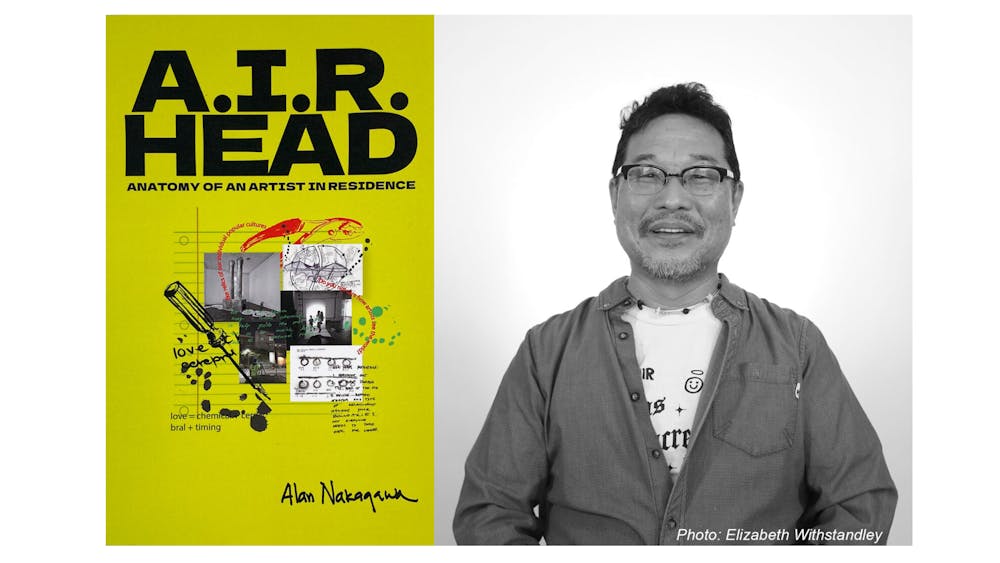I walked into the Philadelphia Print Center in Rittenhouse Square to a welcoming crowd, off a small cobblestone street that made me feel like I had stumbled upon some small European gathering. When I went upstairs, I sat quietly as Alan Nakagawa chatted with the front row of the audience. I could tell he was grateful to be making connections, grounded in experiences, and anxious to talk about his career as an artist. This gratified excitement immediately helped me understand Nakagawa’s ability to find steady success in the ever–unpredictable art world.
Nakagawa is an interdisciplinary artist who works primarily with sound, aiming to incorporate various media and work with diverse communities and their histories. On October 24, he came to the Print Center in Rittenhouse Square to speak about his new—and first—book A.I.R. Head: Anatomy of an Artist in Residence. The event, a part of the Mural Arts Philadelphia “Mural Arts Month” had an impressive audience, including Jane Golden, the heart of Mural Arts, the nation’s largest public art program. However, the majority of the audience came to hear Nakagawa speak about the most impressive facet of his career: his nine artist–in– residencies. Nakagawa has done the impossible. He’s maintained a steady paycheck in the art world for six consecutive years.
Nakagawa is currently the artist–in–resident at the Gerth Archives, California State University Dominguez Hills, and will soon begin his 10th residency at Kaya Press at the University of Southern California. During the event, he shared what it was like to work as a Creative Catalyst Artist in Residence for the Los Angeles Department of Transportation. He explained how working for the city allowed him to complete 12 substantial projects in just one year. Top–down support, and a less bureaucratic environment, Nakagawa explained, make a residency that much better.
He detailed his artistic process in creating the Mar Vista Great Streets Project. He explained that the public transport system, like many governmental systems, functions as a political machine, to which the addition of art is a foreign unwelcome entity. Nevertheless, his Mar Vista Great Streets Project seamlessly solved the problem it intended to fix. In an effort to slow down the adjacent freeway, Nakagawa enlisted a local poetry group to write 36 haikus about transportation. Placing the haikus on the freeway's bike lane signs, the project successfully promoted traffic safety and slowed down drivers on the freeway.
In addition to his projects as an artist in residence, Nakagawa also detailed one of his most famous projects Peace Resonance: Hiroshima/Wendover. After receiving the opportunity to visit the Wendover Hanger, where in 1945 the Enola Gay B–29 Bomber flew out of to drop atomic bombs on Hiroshima and Nagasaki, he felt compelled to re–link the hangar with the Hiroshima Atomic Dome. Through his relationship with the city of Los Angeles through his residencies, the mayor of LA wrote a letter to the mayor of Hiroshima on his behalf. After receiving near–impossible permission to go into the Atomic Dome, he brought in three recorders and took sound recordings for 17 minutes. This he said, creates an “invisible architecture” that he later played in the Wendover hanger. To him, the work is about “history, immigration, resilience, and time.” Nakagawa’s family is from Hiroshima, and the work serves as a portrait of what it is like to be a Japanese–American in post-WWII America, filled with irony and ambiguity.
His book, A.I.R.Head: Anatomy of an Artist in Residence details his nine residencies and the many amazing opportunities he’s had as an artist. How he got those opportunities he says: he grew up in his parent’s restaurant watching them interact with customers, he learned social cues, and understood people. Nakagawa knows “nothing continues in the arts," but he’s grateful that he keeps getting recommended for such incredible opportunities. Humbled, he expressed that he wasn’t looking to become an author, he just wanted to keep doing art, ceding hope with his work. He’s hopeful that more corporations will enlist him, and countless other creatives to be artists in residence.
Nakagawa concluded the conversation by finishing with his belief that “artists are a necessary catalyst for innovation.”







